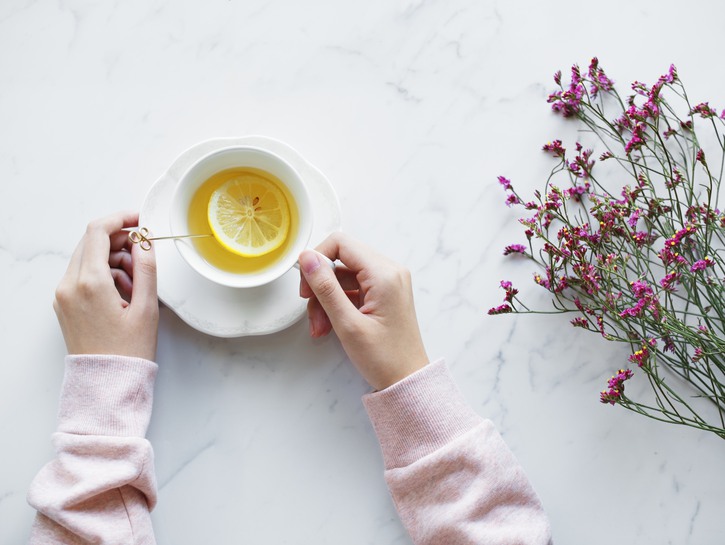Brewing yourself a cup of tea on a rainy day, a cool autumn afternoon, or right before bed is a relaxing way to wind down after a long day. Between the different loose leaf teas available in stores and the assortment of flavors from chains like David’s Tea, you have a healthy selection available to bring you some peace during the day. Though it seems like a simple process, the different flavors and types of tea each require their own brewing methods and temperatures. So, relax, grab your favorite flavor, and learn how to make tea the right way.
General Brewing Tips

- Always fill your kettle with fresh, cold water.
- Avoid pouring boiling water directly on top of your loose leaf tea or teabags. In order to receive all the benefits and flavor let your water sit for 2-4 minutes before pouring it into your teapot or mug.
- You should use a teaspoon of tea per 8 oz of water in your mug unless otherwise specified.
- To prevent a bitter taste, don’t steep your tea for longer than required. If you’re looking for a stronger tea you should add more tea leaves to your infusers or teabags or use more than one teabag.
- Another way to avoid bitter tea is to gently squish your teabag against the side of your mug before pulling it out. Don’t do it more than once, though, or you’ll get a bitter taste.
- Take care to remember that someteas have caffeine in them so always look at the label and don’t brew too many cups in order to avoid getting buzzed.
The top tip to remember is that making tea to cater your personal preferences is the best way to brew a perfect cup. The general guidelines and following steeping times are meant to help you perfect your tea game without taking away from your needs!
Different Teas Require Different Care
Now that you’ve brushed up on how to make tea let’s briefly go over the assortment out there and how to properly make the best cup. They each require different temperatures and brewing times but don’t let the guidelines deter you from doing things your way. If you find that certain times or amounts work best for you, go ahead and do what’s best for you.

Black Tea: Use 1-2 teaspoons for 8 ounces of water. Brew at a temperature of 195-210 degrees Fahrenheit and let it steep for 3-5 minutes.
White Tea: Use 1-2 teaspoons per 8 ounces of water. Brew at a temperature of 170-180 degrees Fahrenheit and let it steep for 3-5 minutes.
Green Tea: Use 1-2 teaspoons for 8 ounces of water. Brew at a temperature of 175-185 degrees Fahrenheit and let it steep for 1-3 minutes.
Oolong Tea: Use 1-2 teaspoons for 8 ounces of water. Brew at a temperature of 185-205 degrees Fahrenheit and let it steep for 3-5 minutes.
Pu-erh Tea: Use 1-2 teaspoons for 8 ounces of water. Brew at a temperature of 190-205 degrees Fahrenheit and let it steep for 3-4 minutes.
Herbal Tea: Use 1-2 teaspoons for 8 ounces of water. Brew at a temperature of 195-210 degrees Fahrenheit and let it steep for 5-6 minutes.
Flavor Your Tea

With promises of citric twists and berry flavorings to some of our favorite teas, we may never have thought about adding anything other than sweetener or honey into our mugs. But there are several ingredients you can use to enhance your tea all the more.
Lemon
Adding a lemon wheel to your cup of tea not only serves as a sweetener but also gives off a citric twist to add a dash of something extra. Like Splenda or stevia, citric twists are low-calorie additions to your beverage that add a sweet flavor. You can also stray away from the classic lemon by adding in some freshly squeezed orange juice or an orange wheel.
Cinnamon
A traditional choice for tea-lovers, sprinkling in some cinnamon or placing a cinnamon stick to your brew adds a warm spice. A popular addition during the colder months, cinnamon is also known to boost your metabolism so it’s a go-to for those who need a bit of a healthy boost. Cinnamon provides tea-drinkers with a bit of added spice as well, so this is often a popular choice for those chasing after a kick.
Berries
Just like with citrus, there are lots of different berries you can select for your tea. Blackberries, raspberries, strawberries, and blueberries all give your tea some added sugar and texture. If your tea is something a little more mild like green or herbal, berries provide some flavor that may have been lacking. You can also munch on the berries afterward, making them a two-for-one deal.
Mint
A refreshing taste and a known soother for upset stomachs, mint is a natural herb that can be added for a slight enhancement in flavor or to calm any looming nausea. This herb also gives off a sweet taste that isn’t too overwhelming, which gives your tea a small punch. An added bonus is the well-loved scent that mint gives off, too.
Ginger
Speaking of upset stomachs, ginger comes with a collection of health benefits including calming nausea, reducing flu symptoms, and helping with digestion. The taste of ginger is one that many tea-drinkers love and oftentimes people add ginger solely for the boost in flavor. This is also a great addition if you’re hoping to add a bit of spice to your tea.

Tea is a relaxing way to bring yourself some peace and quiet after a long day at the office or if you just need a few minutes to yourself. Choosing your favorite flavor of tea and enjoying a few minutes of solitude is bound to put your mind and body at ease.
